Autumn is often described as nature’s grand finale, a spectacular show where trees dress themselves in fiery hues of crimson, gold, orange, and bronze before winter’s rest. For homeowners, gardeners, and landscape enthusiasts, fall is the season when trees truly shine. The right trees can transform an ordinary yard into a breathtaking seasonal canvas, offering not only stunning visual beauty but also benefits such as supporting wildlife, providing shade, and even enhancing property value.
If you’re looking to elevate your garden or backyard this season, here are the top fall trees for a stunning landscape, with detailed insights on their beauty, growth habits, and how to best use them in your space.
🍁 1. Sugar Maple (Acer saccharum)
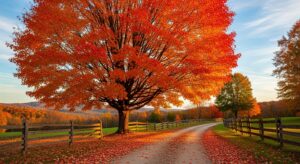
No list of fall trees would be complete without the sugar maple, the tree that inspired New England’s postcard-perfect autumn landscapes. Its large, five-lobed leaves burst into shades of fiery orange, scarlet, and gold in late September through October.
-
Best for: Large yards, driveways, or as a central focal point.
-
Height & Spread: 60–75 feet tall, wide canopy.
-
Extra perk: It’s the source of maple syrup!
🌟 Landscape Tip: Plant sugar maples where they’ll catch the afternoon sun. The golden light will make their leaves glow like stained glass.
🌳 2. Red Maple (Acer rubrum)

True to its name, the red maple dazzles in autumn with leaves that range from brilliant crimson to burgundy tones. Unlike the sugar maple, it changes color early, extending your fall display season.
-
Best for: Suburban yards, city gardens (it tolerates pollution).
-
Height & Spread: 40–60 feet tall.
-
Soil preference: Moist but well-drained soils.
🌟 Landscape Tip: Combine red maples with golden-leaved trees like ginkgo for a contrasting autumn palette.
🍂 3. Japanese Maple (Acer palmatum)
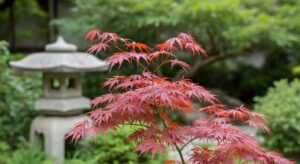
Compact yet dramatic, the Japanese maple is a designer’s dream. Its finely cut leaves glow in burgundy, crimson, and orange during fall. This tree works especially well for small gardens or as a showpiece in landscaped courtyards.
-
Best for: Patios, courtyards, Zen gardens.
-
Height & Spread: 10–25 feet tall (depending on variety).
-
Extra charm: Year-round beauty, with striking branch structure in winter.
🌟 Landscape Tip: Pair Japanese maples with stone lanterns, ornamental grasses, or water features for a serene, artistic feel.
🍃 4. Sweetgum (Liquidambar styraciflua)
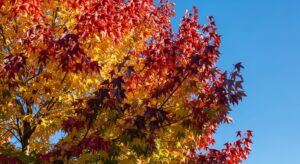
The sweetgum is a spectacle of multicolored foliage, turning purple, red, yellow, and orange all at once. Its star-shaped leaves are distinctive, and the spiky seed pods provide textural interest through winter.
-
Best suited for: Large properties with ample space.
-
Height & Spread: 60–75 feet tall.
-
Wildlife benefit: Its seeds feed birds like goldfinches and sparrows.
🌟 Landscape Tip: Plant sweetgums along property borders for a natural, colorful screen.
🍁 5. Ginkgo (Ginkgo biloba)
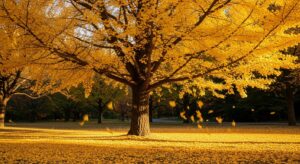
The ginkgo tree is a living fossil, over 200 million years old, and still one of the most striking fall trees. Its fan-shaped leaves turn a radiant golden yellow, often all at once, carpeting the ground in gold.
-
Best for: Driveways, courtyards, city landscapes.
-
Height & Spread: 50–80 feet tall.
-
Low-maintenance: Tolerates pollution, pests, and poor soils.
🌟 Landscape Tip: Choose a male ginkgo tree, as female trees produce messy fruit with an unpleasant odor.
🌳 6. Oak Trees (Quercus species)
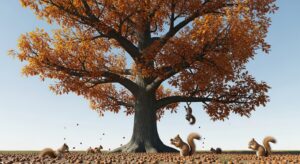
Oaks are symbols of strength and endurance. In fall, different species showcase a variety of shades: red oaks turn crimson, pin oaks glow russet, and white oaks shift to warm bronze.
-
Best for: Large landscapes and long-lasting shade.
-
Height & Spread: 60–100 feet tall.
-
Wildlife benefit: Acorns provide essential food for deer, squirrels, and birds.
🌟 Landscape Tip: Plant oaks for heritage value, they live for centuries and become part of your landscape’s legacy.
🍂 7. Black Tupelo (Nyssa sylvatica)
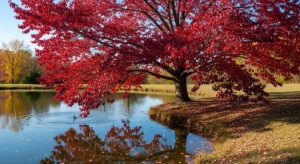
Also called black gum, this tree offers some of the most intense red, orange, and purple fall colors. Its glossy leaves shimmer, making its colors appear especially vivid.
-
Best for: Mid-sized yards and naturalized landscapes.
-
Height & Spread: 30–50 feet tall.
-
Wildlife benefit: Its berries attract birds like robins and woodpeckers.
🌟 Landscape Tip: Plant near water features, its reflective fall color doubles the beauty.
🍃 8. Dogwood Trees (Cornus florida)
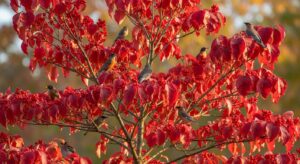
Dogwoods aren’t just springtime beauties with their white or pink blossoms. In fall, their foliage turns crimson and purple, while clusters of bright red berries attract cardinals and other songbirds.
-
Best for: Smaller yards and woodland edges.
-
Height & Spread: 15–30 feet tall.
-
Multi-season charm: Spring blooms, fall foliage, winter berries.
🌟 Landscape Tip: Plant dogwoods along a woodland border for a natural four-season display.
🍁 9. Serviceberry (Amelanchier)
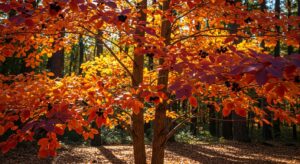
A multi-season wonder, the serviceberry delivers stunning orange, gold, and reddish-purple fall foliage. It also produces edible berries in summer, loved by both birds and humans.
-
Best for: Smaller gardens, wildlife-friendly yards.
-
Height & Spread: 15–25 feet tall.
-
Extra charm: White spring flowers and smooth gray bark in winter.
🌟 Landscape Tip: Grow serviceberry in clusters for a woodland, layered effect.
🍂 10. Bald Cypress (Taxodium distichum)
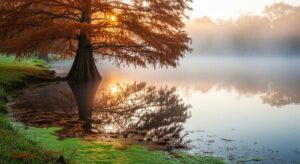
Unique among conifers, the bald cypress is deciduous. Its feathery needles turn a rich rusty orange-brown before dropping in fall, leaving behind dramatic sculptural trunks.
-
Best for: Wet areas, pond edges, or rain gardens.
-
Height & Spread: 50–70 feet tall.
-
Wildlife benefit: Provides nesting sites for birds.
🌟 Landscape Tip: Plant in groups near water for a mystical, swampy ambiance.
🌳 11. Sourwood (Oxydendrum arboreum)
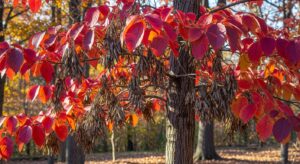
Though less common, the sourwood delivers unforgettable fall beauty. Its leaves shift to brilliant crimson and purple, while its summer flower clusters turn into decorative seed pods.
-
Best for: Accent planting in medium-sized gardens.
-
Height & Spread: 20–30 feet tall.
-
Wildlife benefit: Bees love its summer blooms for honey production.
🌟 Landscape Tip: Pair with evergreens for contrast; the fiery foliage will pop against deep greens.
🍁 12. Sassafras (Sassafras albidum)
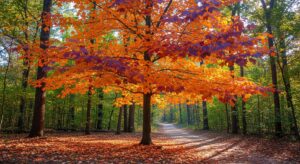
Quirky and colorful, the sassafras tree produces an astonishing palette of yellow, orange, red, and purple, often all on the same tree. Its mitten-shaped leaves make it easily recognizable.
-
Best for: Naturalized areas and cottage-style landscapes.
-
Height & Spread: 30–60 feet tall.
-
Wildlife benefit: Host plant for spicebush swallowtail butterflies.
🌟 Landscape Tip: Use sassafras as a conversation piece in your yard; it’s unusual and unforgettable.
🍂 Tips for Designing a Stunning Fall Landscape
-
Layer colors – Mix trees with yellow, red, and purple foliage for a multi-toned landscape.
-
Stagger timing – Choose early and late color-changing trees for a season-long show.
-
Add contrast – Pair deciduous fall trees with evergreens to enhance visual drama.
-
Think wildlife – Choose trees like serviceberries and dogwoods to support birds.
-
Highlight with light – Plant trees where fall sunlight can backlight the foliage.
🌟 Final Thoughts
Fall is nature’s most vibrant season, and by carefully choosing the right trees, you can create a landscape that glows with warmth, richness, and texture. From the glowing gold of ginkgoes to the fiery blaze of sugar maples and the multicolored magic of sassafras, there’s a fall tree to suit every garden style and size.
🍁✨ With thoughtful planting, your yard won’t just look beautiful, it will become a seasonal sanctuary where every leaf tells the story of autumn’s magic.
❓ FAQs About Top Fall Trees for a Stunning Landscape
1. 🍁 What are the best trees for fall color?
Some of the best trees include sugar maple, red maple, Japanese maple, ginkgo, and sweetgum, all known for their vibrant autumn foliage.
2. 🌳 Which fall tree grows the fastest?
Red maple and sweetgum are among the fastest-growing fall trees, making them great choices if you want quick color in your yard.
3. 🍂 Which tree has the brightest red leaves in autumn?
The red maple is famous for its vivid scarlet foliage, while black tupelo and sourwood also deliver deep red tones.
4. 🌟 What tree turns the brightest yellow in fall?
The ginkgo tree is unmatched for its golden-yellow fan-shaped leaves that light up the landscape.
5. 🍃 What fall tree is best for small gardens?
Japanese maple, serviceberry, and dogwood are excellent for smaller yards, as they provide big color in compact spaces.
6. 🐦 Do fall trees help wildlife?
Yes! Serviceberries, dogwoods, and oaks produce berries or acorns that provide food for birds, squirrels, and other wildlife.
7. 🪵 Which fall tree provides great shade?
Large canopy trees like sugar maple, oak, and red maple are perfect for creating shady spots while still showing off bold fall colors.
8. 🍁 When is the best time to plant fall trees?
The best time is early fall or spring, when the soil is moist and temperatures are mild, helping roots establish before extreme weather.
9. 🌲 Are there fall trees that grow well near water?
Yes! The bald cypress thrives near ponds or wetlands, and its rusty-orange fall foliage creates a beautiful reflection in water.
10. 🍂 Can I mix different fall trees for a longer display?
Absolutely! Planting a mix of early-changers like red maples and later-color trees like ginkgo ensures a season-long show of autumn color.